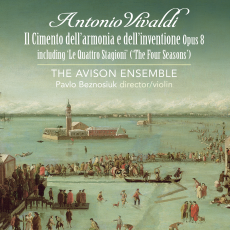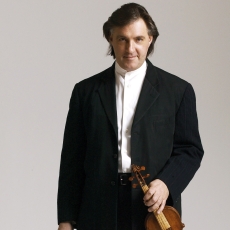The Avison Ensemble - Vivaldi: Concerti Opus 8 - Fanfare
Antonio Vivaldi's op. 8 concertos, Il Cimento dell'armonia e dell' inventione, sound crisp and sharply etched in Linn's release of the entire set on SACD, but violinist Pavlo Beznosiuk (playing a 1676 Matthys Hoffmans violin from Antwerp) and the Avison Ensemble offer a great deal more than simple crackle and pop in encrustations of ornamentation like those that make their appearance in the slow movement of "Spring" (as well as in that of "Summer"). These extra expressive elements include a rhythmic vitality that never expresses itself in extreme contrasts of tempo or dynamics that have become almost pro forma among period practitioners. Soloist and ensemble, in fact, take the opening movement of "Summer" at a gracious tempo that allows its birds to sing without being forced and its storms to contrast with the season's oppressive heat and humidity. Beznosiuk's restraint in the slow movement renders the calm before the last movement's storm all the more ominous, while the tempest itself never rages so fiercely that the instrumentalists lose their edge. "Autumn" begins with a more legato approach to the main tutti theme, which Beznosiuk extends to the solo's double-stopped version of the same motive. He doesn't eschew the work's pictorial aspects, as his rendering of drunken napping near the first movement's end and the death of the prey in the last movement's hunt demonstrate. Neither does the ensemble portray the opening of "Winter" in shockingly abrasive timbres to limn the season's bone-chilling cold. But he takes the slow movement of "Winter" at a quick tempo that helps free it from the Romanticism that can threaten to overwhelm it.
The ensemble's clean articulation in the opening of the fifth concerto, "La Tempesta di mare," allows individual lines to emerge from the gale-force passages despite the turbulence. Beznosiuk adds piquant decoration at the end of the slow movement, and the ensemble opens the finale vigorously. The sixth concerto also bears a title, "Il Piacere"; both violinist and ensemble create lift in the sunny passages of its first and third movements. The second movement provides them with a wider scope for interpretive subtlety, though their carefully calibrated effects in the finale demonstrate equally careful planning. The seventh concerto, which bears no title, originally dedicated to Johann Georg Pisendel, according to Simon D. I. Fleming's booklet notes, may not sound so virtuosic, but Beznosiuk and the ensemble play off the violin's melting line in the slow movement against its accompaniment. The eighth concerto's swirling figuration over pedal points in the third movement overcomes any perceived want of virtuosity in the seventh, and Beznosiuk is sensational rather than simply efficient in these extended passages. The ninth concerto, the solo part of which can also be played by an oboe, offers a suave contrast to the 10th, "La caccia," which extends the venereal scenes in "Autumn." Beznosiuk proves a sprightly hunter who stalks and strikes his prey with the precision of an archer rather than with the blunt force of a bludgeoner. The ensemble sounds equally starchy in the contrapuntal opening of the 11th concerto; a similar approach by Beznosiuk to the solo passages suggests not only lines double-stopped but a razor double-stropped. His lyricism in the slow movement mitigates this effect somewhat before the finale begins, again contrapuntally but this time more lushly in both tutti and solo parts. Beznosiuk plays the rapid figuration with pellucid lightness and ease. The reading of the 12th concerto overflows with good spirits in the first movement, bristles with effective ornament in the second, and ends with a genial smile in the finale.
Throughout, Beznosiuk produces a pinched sound, perhaps characteristic of gut strings but more pronounced than timbres associated with exponents of period instruments like Simon Standage and even Andrew Manze. Still, those who prefer the sound of modern instruments shouldn't be put off, since Beznosiuk plays with such expressive flexibility. Strongly recommended, in part because of the advantage that SACD sound confers.


